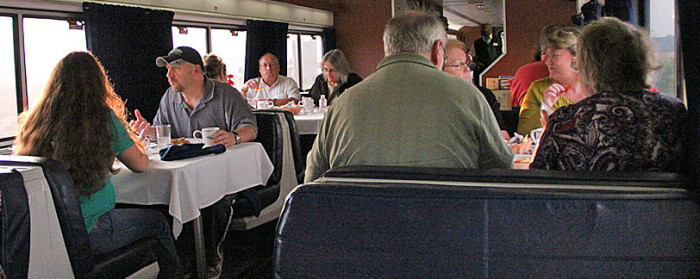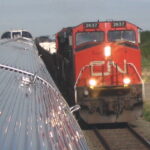A Passenger’s Diary: From Fort Worth to L.A. on Amtrak.
Many long-time Amtrak travelers keep notes and generate trip reports which they share with others. What follows are some quotes from a rather detailed report by a veteran rail traveler. The writer was traveling with his wife in a sleeping car, first on the Texas Eagle from Fort Worth to San Antonio, Texas, and then from San Antonio to Los Angeles on the Sunset Limited.
(The Eagle runs daily from Chicago to San Antonio, where it becomes part of the Sunset Limited consist three days a week as the two trains continue to Los Angeles. It was unclear from his report why they switched cars in San Antonio. Either they booked the two segments separately or they spent a day or two in San Antonio.)

The first unusual occurrence was a P.A. announcement that there would be two dinner seatings: 5:00 and 5:30. When asked, the LSA (Lead Service Attendant) crisply replied that there couldn’t be any after those times “on days we go to San Antonio.”
Note: On Amtrak’s long-distance trains, passengers are offered dinner seatings usually starting around 5:30 and sometimes extending as late as 7:30. And the LSA’s explanation was total B.S. because the Eagle goes to San Antonio every day. Our correspondent continues:
Perplexed, I did not continue the discussion. When we arrived for our 5:00 seating we ordered dinner, and the service crew was excellent. But it still is curious why they couldn’t have scheduled a few later seatings.
Well, I’m happy to provide the most likely answer: the normal dining car routine was being altered for the convenience of the on board crew. I can think of no valid reason for requiring all passengers to have what would be a very early dinner for many of us.
Our car is one that has not been fully updated and has the old carpeted walls that now look quite shabby and dirty.
It is a sad fact that Amtrak’s rolling stock is old—as much as 35 years old—and in need of replacement or renovation. Traveling in an old coach for a few hours is one thing; spending the better part of three days and two nights traveling across the country in an old Superliner sleeping car is something else entirely.
The writer goes on to describe how, over lunch in the dining car, several of the coach passengers were accusing others about some rowdy behavior during the previous night. Apparently, the argument grew heated, but the Amtrak crew did nothing to calm the situation.
This turn of events was not conducive to a pleasant luncheon experience for us and we chose not to go [to the dining car] for dinner, forfeiting that paid-for meal. Instead, we ordered some snacks from the Lounge, which our attendant brought us.
This makes no sense to me. If dining car meals are included in your fares, why would you opt for “ordering snacks from the Lounge” … snacks you have to pay for? Either way, the car attendant will bring the food to your accommodations.
Bottom line to the above: Service on Amtrak’s long-distance trains is inconsistent and, in some cases, passengers do not receive the experience they’re paying for because procedures are changed for the convenience of the on-board crew. Cost-cutting diminishes the sleeping car passengers’ experience, so ridership declines, causing more cost-cutting. And the cycle continues with one likely conclusion. And it is to weep.




This is why airlines have pursers and even VIA Rail Canada has a service director and service manager on “The Canadian.”
The only consistency to traveling on Amtrak is the inconsistency of every crew on every train, due to a lack of a chain-of-command with one person in control. This function used to be provided by the Passenger Service Rep; later, the Train Chief. However, neither program worked out at Amtrak. Rather than studying VIA Rail’s success in recruiting and developing these on-board leadership positions, Amtrak elected to outsource its HR function-to a firm with no apparent rail experience or understanding of the characteristics and skills required to successfully recruit, train, orientate, and retain.